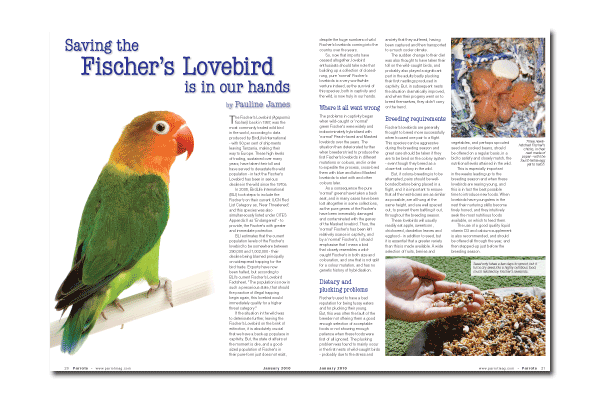Saving the Fischer's Lovebird is in our hands
by Pauline James
The Fischer’s Lovebird (Agapornis fischeri) back in 1987, was the most commonly traded wild bird in the world, according to data produced by BirdLife International - with 80 per cent of shipments leaving Tanzania, making their way to Europe. These high levels of trading, sustained over many years, have taken their toll and have served to devastate the wild population - in fact the Fischer’s Lovebird has been in serious decline in the wild since the 1970s.
In 2008, BirdLife International (BLI) took steps to include the Fischer’s on their current IUCN Red List Category as, ‘Near Threatened,’ and this species was also simultaneously listed under CITES Appendix II as ‘Endangered’ - to provide, the Fischer’s with greater and immediate protection.
BLI estimates that the current population levels of the Fischer’s lovebird to be somewhere between 290,000 and 1,002,000 - their decline being blamed principally on widespread trapping for the bird trade. Exports have now been halted, but according to BLI’s current Fischer’s Lovebird Factsheet, “The population is now in such a precarious state, that should the practice of illegal trapping begin again, this lovebird would immediately qualify for a higher threat category.”
If the situation in the wild was to deteriorate further, leaving the Fischer’s Lovebird on the brink of extinction, it is absolutely crucial that we have a back-up populace in captivity. But, the state of affairs at the moment is dire, and a good-sized population of Fischer’s in their pure-form just does not exist, despite the huge numbers of wild Fischer’s lovebirds coming into the country over the years.
So, now that imports have ceased altogether, lovebird enthusiasts should take note that building up a collection of closed-rung, pure ‘normal’ Fischer’s lovebirds is a very worthwhile venture indeed, as the survival of this species, both in captivity and the wild, is now truly in our hands.
Read more in the magazine…









Parrot Chat
Buyers Guides
Breeding articles